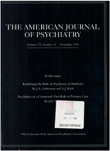Anxiogenic effects of CO2 and hyperventilation in patients with panic disorder
Abstract
OBJECTIVE: Previous studies have indicated that patients with panic disorder are more likely than normal subjects to have acute panic attacks during inhalation of CO2, but methodological objections have been raised. In this study the authors attempted to address three of these methodological problems by ensuring that raters who assessed whether panic attacks occurred were blind to subjects' diagnoses, by randomizing the order of administration of 5% CO2 and hyperventilation, and by challenging a greater number of subjects with 7% CO2. METHOD: Patients with panic disorder and normal subjects underwent 20-minute inhalations of 5% CO2 and 7% CO2 and 15 minutes of room-air hyperventilation. Ratings of panic/no panic during each condition were made separately by an assessor blind to diagnosis and by the subject. Scores on four panic rating scales were also recorded before and after each intervention. RESULTS: Room-air hyperventilation caused panic attacks in a small number of patients; the difference in panic rate between patients and comparison subjects was statistically significant by the subjects' but not by the raters' assessment. Panic rates during 5% CO2 and 7% CO2 were significantly greater among the patients by both assessments; the panic rate was greatest during 7% CO2. Order of administration did not significantly affect panic rates for hyperventilation and 5% CO2. CONCLUSIONS: Panic patients were clearly more sensitive to the anxiogenic effects of CO2 than comparison subjects, and CO2 was a more potent anxiogenic stimulus than room-air hyperventilation. Seven percent CO2 discriminated best between patients and comparison subjects and should be the focus of further research.
Access content
To read the fulltext, please use one of the options below to sign in or purchase access.- Personal login
- Institutional Login
- Sign in via OpenAthens
- Register for access
-
Please login/register if you wish to pair your device and check access availability.
Not a subscriber?
PsychiatryOnline subscription options offer access to the DSM-5 library, books, journals, CME, and patient resources. This all-in-one virtual library provides psychiatrists and mental health professionals with key resources for diagnosis, treatment, research, and professional development.
Need more help? PsychiatryOnline Customer Service may be reached by emailing [email protected] or by calling 800-368-5777 (in the U.S.) or 703-907-7322 (outside the U.S.).



